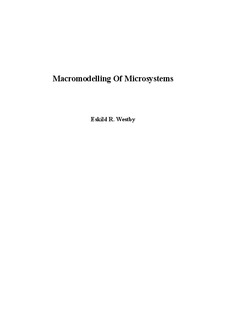| dc.description.abstract | The aim of this work has been to develop new knowledge about macromodelling of microsystems. Doing that, we have followed two different approaches for generating macromodels, namely model order reduction and lumped modelling. The latter is a rather mature method that has been widely recognized and used for a relatively long period of time. Model order reduction, on the other hand, is a relatively new area still in rapid development. Due to this, the parts considering reduced order modelling is strongly biased towards methodology and concepts, whereas parts on lumped modelling are biased towards systems and devices.
In the first part of this thesis, we focus on model order reduction. We introduce some approaches for reducing model order for linear systems, and we give an example related to squeeze-film damping. We then move on to investigate model order reduction of nonlinear systems, where we present and use the concept of invariant manifolds. While the concept of invariant manifolds is general, we utilize it for reducing models. An obvious advantage of using invariant manifold theory is that it offers a conceptually clear understanding of effects and behaviour of nonlinear system.
We exemplify and investigate the accuracy of one method for identifying invariant manifolds. The example is based on an industrialized dual-axis accelerometer.
A new geometrical interpretation of external forcing, relating to invariant manifolds, is presented. We show how this can be utilized to deal with external forcing in a manner consistent with the invariance property of the manifold. The interpretation also aids in reducing errors for reduce models.
We extend the asymptotic approach in a manner that makes it possible to create design-parameter sensitive models. We investigate an industrialized dual-axis accelerometer by means of the method and demonstrate capabilities of the method. We also discuss how manifolds for nonlinear dissipative systems can be found.
Focusing on lumped modelling, we analyse a microresonator. We also discuss the two analogies that can be used to build electrical equivalents of mechanical systems. It is shown how the f → V analogy, linking velocity to voltage, is the natural choice. General properties of lumped modelling are investigated using models with varying degrees of freedom.
Finally, we analyse an electromagnetic system, intended for levitating objects, and we demonstrate the scaling effects of the system. Furthermore, we prove the intrinsic stability of the system, although the floating disc will be slightly tilted. This is the first analysis done assessing the stability criterions of such a systems. The knowledge arising from the analysis gives strong indications on how such a system can be utilized, designed, and improved. | nb_NO |
